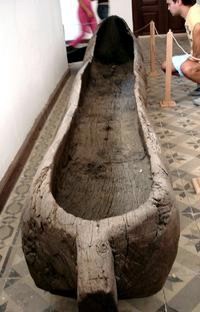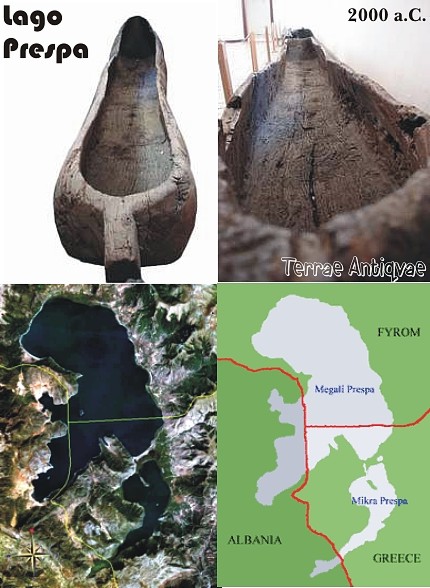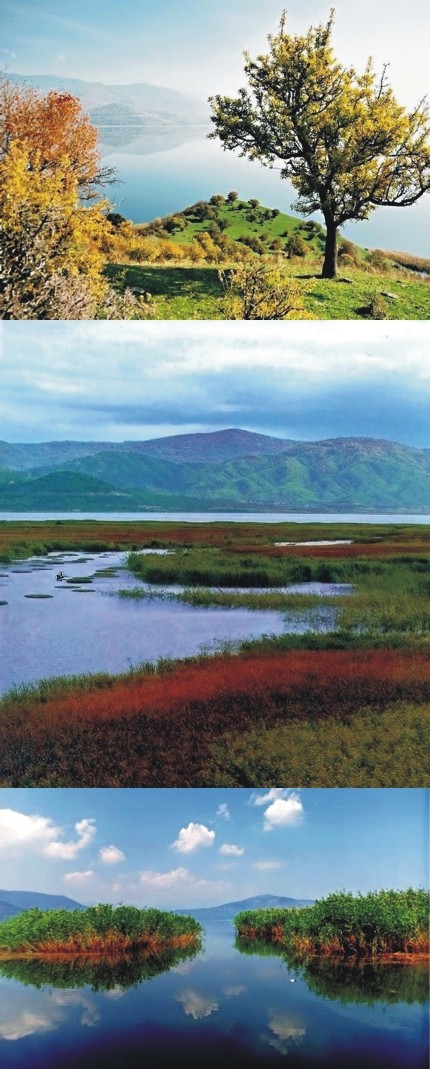Macedonia. Barcas de la edad de piedra 'ancladas' en desecado lago Prespa
De las profundidades del desecado lago Prespa, al sur de Macedonia, han aflorado a la superficie embarcaciones del neolítico que, por falta de dinero para su recogida e investigación, se pierden entre la maleza.
El lago Prespa, el segundo de los tres mayores en este país balcánico -además de los de Ohrid y Dojran-, se encuentra en el extremo sur de Macedonia, lo comparten Grecia y Albania y aquí se suceden en intervalos de siglos fenómenos naturales de relleno y vaciado aunque desaguan los ríos.
Desde finales de los años sesenta del siglo pasado, está en curso el proceso de desecación que ha hecho perder hasta hoy casi un tercio de los 274 kilómetros cuadrados de superficie que el Prespa tiene en circunstancias normales.
Al evaporarse el agua salieron a la superficie vetustas barcas de asentamientos neolíticos que habían estado ocultas durante siglos en el fondo lacustre.
Algunas de estas embarcaciones halladas hace unos 30 años están expuestas en los corredores de la Casa de la Cultura de la ciudad de Resen, próxima al lago.
Los habitantes de la región han advertido en los últimos dos años a las autoridades arqueológicas de la aparición de otros objetos similares a las de estas embarcaciones, pero el Estado nada puede emprender por falta de medios.
Se trata de barcas monolíticas de 5 metros de largo. Eso significa que fueron construidas de troncos ahuecados de un árbol raro, parecido al abeto, de hoja perenne presente también hoy en esta región, explica a Efe, el arqueólogo de Resen, Dimitar Mucevski.
Todos provienen de la zona del pueblo de Nakolec, cuyos habitantes avisaron también la última vez, hace varios meses, de haber vuelto a encontrar partes de barcas neolíticas.
Esta tranquila aldea de unos 30 habitantes se encuentra a sólo tres o cuatro kilómetros de la frontera con Grecia y está poblada mayoritariamente por ancianos, ya que los jóvenes han emigrado durante las últimas décadas a EEUU en busca de una mejor vida.
Nakolec era antaño un pueblo muy interesante y animado. Los viejos lo llamaban la Venecia macedonia. Las casitas de pescadores estaban construidas dentro del lago sobre estacas de madera, de ahí su nombre: na kolec (sobre estacas).
Mi abuela me contaba cómo iban de una casa a otra en barcas y también remaban para asistir a la liturgia en la iglesia de Santo Domingo, dijo a Efe Vera Tuxharova, de 50 años, pero, nada de eso queda, el agua se ha retirado, la gente se ha ido, las casas están en ruinas.
Según se ha ido retirando el lago han ido apareciendo nuevas barcas de la edad de piedra. Ahí abajo apareció una, pero nadie del Estado vino, recuerda Risto, de 34 años, uno de los pobladores que sabe mucho de la historia del pueblo.
El tiempo hizo pronto de las suyas. La gran humedad y el viento caliente del sur hicieron cubrir el desecado fondo lacustre de matorrales de hasta 4 metros de altura y de serpientes, y ya nadie recuerda dónde se encontraban los objetos por el cambio del relieve.
En la capital, Skopje, trabaja el director de la Administración para la protección del tesoro cultural de Macedonia, Pasko Kuzman, conocido arqueólogo de larga cabellera blanca que dirigió hace unos años el proyecto arqueológico en los lagos macedonios.
Buceé con un equipo debajo de la aldea de Nakolec. Teníamos datos de que había por ahí un asentamiento neolítico de hace 7.000 años. Nada hallamos porque concluimos que el agua se había retirado más de lo que pensábamos. Tenemos que buscar el asentamiento y nuevas barcas en tierra, explica Kuzman a Efe.

Añadió que Nakolec es un sitio extraordinario, pero que sin dinero nada se puede hacer y espera que si el país recibe algunos fondos de la Unión Europea (Macedonia es desde el año pasado candidato al ingreso en la UE), con esos medios se podrían iniciar algunos sondeos e indagaciones arqueológicas.
Hasta entonces, nadie sabrá cuántas barcas de la edad de piedra esperan ancladas en el fondo desecado y cubierto de vegetación del lago Prespa.
Fuente: Terra Actualidad EFE, 26 de septiembre de 2006
Enlace: http://actualidad.terra.es/ciencia/articulo/
barcas_prespa_edad_piedra_ancladas_1107927.htm
(2) Forgotten Macedonian Venice Reveals Pre-Historic Artifacts
Source: Macedonian daily newspaper Vreme
Written by Ivan Blazhevski
Translated by UMDiaspora Staff
For decades now, the Cultural Center in Resen has housed boats, some 4,000 years old. They belonged to the Prespa inhabitants of the Stone Age, and were discovered on the shores of Lake Prespa.
In my 28 years as a professional, I have never heard of these boats, explains Dimitar Mucevski, an archeologist from Resen. I know of foreign archeologists discovering such wooden boats in the pharaohs tombs, but I was not aware of such treasures here in Macedonia. These boats are made out of a single tree trunk, further elaborates Mucevski.
Two years ago some locals contributed to the conservation of the boats dating from the Neolithic Period, and now the three can be seen in Resen free of charge.
Mucevski told us that the boats were discovered near the village of Nakolec. The locals say that similar artifacts are regularly washed up on the shores, but that there are not any sufficient funds or human resources available to conduct an archeological search.
Stone Age boats in Nakolec! We decide to take a trip to this Prespa village. It is situated on the southern most part of the lake, at 850 meters above sea level, between Dolno Dupeni and Ljubojno. The village was on the very edge of the lake once; today, the water has withdrawn almost 1 kilometer.
Will we be able to find the Stone Age domiciles that have been hidden in the lakes depth for centuries? Experts say that oxygen-deprived wood, located under water, under ground, or frozen, may remain intact for centuries. The three boats we saw in Resen are about 5 meters long. At the bottom, one can see the carvings that mark out the individual seats.
Nakolec is quiet. It is almost 3:00pm, and there is not a single soul on the streets; all hiding away from the summer heat. We finally come across Risto, a 35-year-old man who has lived his entire life in Nakolec. During our conversation, the cruel reality of things is exposed:
No big deal. We have had many items like that washed up on shore for years, but they have all been rotting for some time. Nobody even remembers how many different items there have been.
I am reminded of a statement by archeologist Viktor Lilcik, who said that, out of some 10,000 archeological locations, Macedonia has protected only about 150. However, this prehistoric location is not recorded anywhere.
You see that church over there? Twenty years ago, the water went all the way up to it. After it was drained, many wooden items came up there. Go and see for yourself, but I doubt you will find anything there now, Risto informs us.
We go there, walking upon what once was the lakes bottom. We find nothing. Not a single spike or sign of the boats and artifacts that have been washed up there in the past years. We return home, even though, under our very own feet, we may be leaving behind the gondolas of the prehistoric fishermen.
Nakolec -- the Macedonian Venice
The three boats, dating from the beginning of the New Stone Age period (ca 2000 BC) were carved out of a type of evergreen tree trunks. It is a type of tree typical for the Prespa region, and in particular to the Golem Grad Island.
Up until 1960, the lake came up into the village, and the church of St. Nicholas was literally in the water. People would go by boat to the church to light up a candle and fish in their yards, tells us Vera Tudzarovska.
The village itself was originally under water, and some 100 years earlier, the houses were erected on wooden pillars.
Between the houses there were water canals, and people would move about in boats. It all looked a little bit like Venice. The name of the village is incredibly appropriate, says Vera. [Nakolec, na -- on; kolec -- spike/pillar, means on a spike, or on a wooden pillar]
Today, Nakolec is a site of villas, visited sporadically by its owners when they come back from the United State for their vacation. People want to restore the old Nakolec and turn it into a big tourist attraction. Some say that there are photographs of the old village. They urge the government to make a plan for this restoration and re-galvanize the regions tourism and economy.
Fuente: United Macedonian Diaspora, 4 de septiembre de 2006
Enlace: http://umdiaspora.org/index.php?
option=com_content&task=view&id=133&Itemid=54


0 comentarios